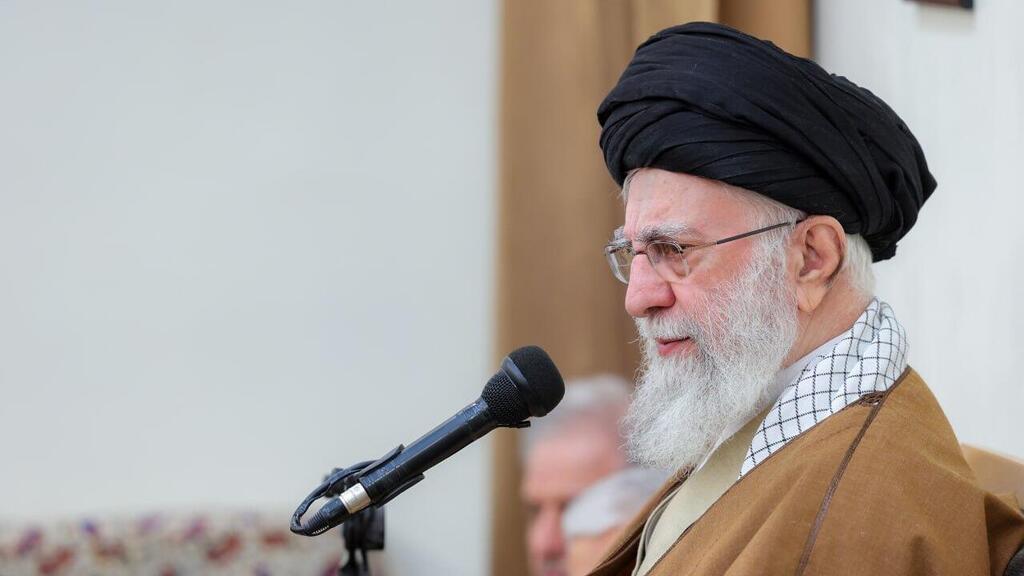Getting your Trinity Audio player ready...
U.S. President Donald Trump blocked a planned Israeli attack on Iran's nuclear sites, as early as next month, in favor of negotiating a deal with the Iranian regime, the New York Times reported, citing sources in the Trump administration.
According to the report, there were two opposing positions in the administration, one including CENTCOM commander Gen. Michael E. Kurilla, who supported Israel's plans, and the other that worried over the United States being drawn into a regional war and demanded that diplomacy be given a chance. The Times claimed Prime Minister Benjamin Netanyahu's hurried visit to the White House earlier this month was to convince the president to approve the attack, an effort that failed.
4 View gallery


US President Donald Trump stopped Prime Minister Netanyahu from going ahead with a strike on Iran's nuclear facilities
(Photos: Avi Ohayon, GPO, IDF Spokesperson)
The decision followed months of internal debate in Washington, the report says. Trump ultimately opted to pursue diplomacy at a time when Iran was considered militarily and economically weakened. The debate highlighted the tension between more hawkish officials and those who questioned whether a military strike could realistically halt Iran’s nuclear ambitions without triggering a broader war. For now, the U.S. consensus appears to oppose military action, especially as Iran has signaled openness to negotiations.
According to the Times, Israeli officials had developed a range of plans for a May strike aimed at slowing Iran’s nuclear program by at least a year. Some Israeli officials were optimistic that the U.S. might approve the plans, which, according to sources briefed on the matter, relied heavily on American involvement—not only for protecting Israel from retaliation but also to ensure the operation's success.
President Donald Trump announces 'direct' negotiations with Iran
(Video: Reuters)
Earlier this month, Trump informed Israeli officials of his decision. He later discussed it with Netanyahu during the prime minister’s visit to Washington, where he used a joint appearance in the Oval Office to announce the start of direct negotiations with Iran. The Times said its reporting was based on discussions with U.S. military and intelligence officials familiar with Israel’s classified plans and on confidential internal administration deliberations.
At Netanyahu’s direction, the IDF initially prepared a plan combining an aerial strike with a commando raid on underground nuclear sites, possibly involving American aircraft. However, Israeli military officials told their U.S. counterparts that the operation would not be ready before October. Seeking a quicker option, Israel began modifying the plan into a broader air campaign that would still require U.S. assistance.
Initially, several American officials, including General Kurilla and National Security Advisor Mike Waltz, were open to considering Israeli proposals. They even explored how the U.S. could potentially support a strike if Trump gave the green light. American officials reportedly agreed that any serious attempt to damage Iran’s nuclear infrastructure would require U.S. support.
With White House approval, Kurilla began transferring military assets to the region. The aircraft carrier USS Carl Vinson arrived in the Persian Gulf, joining the USS Harry Truman in the Red Sea. The U.S. deployed two Patriot missile batteries, a THAAD system in Israel, and six B-2 stealth bombers to Diego Garcia in the Indian Ocean. Additional fighter jets were also under consideration for deployment, possibly to Israeli bases.
4 View gallery


Vice President J.D. Vance warned against a strike on Iran
(Photo: Leah Millis/Reuters)
While these assets could be used in operations against the Iran-backed Houthis in Yemen—whom the U.S. began targeting just over a month ago—U.S. officials acknowledged to the Times that the deployments were also part of contingency planning for supporting an Israeli strike on Iran. Even if American planes were not to take part in the initial attack, their presence could help deter or counter an Iranian response.
There were signs Trump was open to a military option. His social media posts reinforced that perception. But even as military assets moved into position, skepticism grew within the administration about the wisdom of backing an Israeli strike. For weeks, officials debated the matter and, earlier this month, opponents of the plan gained the upper hand.
Oval Office meeting, and the reason for Netanyahu's visit to Washington
The decisive Oval Office meeting came earlier this month. Director of National Intelligence Tulsi Gabbard presented a new intelligence assessment warning that the concentration of American military forces in the region increased the risk of a broader conflict with Iran—one the U.S. was not seeking. American intelligence also warned that a strike could easily spiral into a larger war. Both Israeli and American officials recently reaffirmed their assessment that an Israeli strike would trigger an Iranian response and likely draw the U.S. into a rapidly escalating conflict.
A number of senior U.S. officials backed Gabbard's assessment. Chief of Staff Susie Wiles, Defense Secretary Pete Hegseth and Vice President J.D. Vance all expressed doubts about the prudence of a strike. Some feared it would lead to a regional war and push Iran to make a final decision to build nuclear weapons. Even Waltz, a leading hawkish voice who had previously argued that Iran was vulnerable, expressed skepticism that an Israeli strike could succeed without U.S. assistance.
The Oval Office meeting occurred shortly after a shift in Iran’s posture. While Supreme Leader Ali Khamenei appeared to reject a direct talks proposal Trump sent on March 12, an Iranian official later responded on March 28 with a willingness to engage in indirect talks. A significant debate remains within Trump’s team over the kind of deal Iran would accept, but at that meeting Vice President Vance, backed by others, argued that Trump had a rare opportunity to reach a historic agreement. Administration sources said that if talks were to fail, Trump could then support an Israeli strike.
During a visit to Israel on April 1–2, Kurilla told Israeli officials that the White House wanted to halt preparations for an attack. On April 3, while visiting Hungary, Netanyahu phoned Trump. According to Israeli sources, the U.S. president declined to discuss Iran policy over the phone and invited Netanyahu to the White House. Netanyahu arrived on April 7.
Although the visit was publicly framed as an opportunity to discuss Trump’s new tariffs plan, the key topic for Israel was the proposed strike. Yet, with Netanyahu at his side, Trump used the Oval Office appearance to announce the opening of negotiations with Iran. In private, he told Netanyahu he would not back an Israeli strike in May if talks progressed. The next day, Trump clarified his stance: “If a military solution is needed, that’s what will happen. Israel, of course, would lead it,” he said.
Following Netanyahu’s visit, Trump sent CIA Director John Ratcliffe to Israel. Last Wednesday, Ratcliffe met with Netanyahu and Mossad chief David Barnea to discuss Iran. According to a source familiar with the matter, a wide range of options remains under discussion—including joint covert operations and stricter enforcement of sanctions.
4 View gallery


Benjamin Netanyahu and Donald Trump in the Oval Office
(Photo: Kevin Dietsch/Getty Images)
Netanyahu initially favored a complex plan combining airstrikes with commando raids—essentially a much more ambitious version of a raid conducted in Syria last September, in which Israeli forces landed by helicopter and destroyed a Hezbollah-linked underground missile facility.
Israeli officials believed that, for such an operation to succeed, U.S. aircraft would need to provide cover fire and defend ground forces. But even with U.S. backing, Israeli officials told their American counterparts that planning such a mission would take months. With Kurilla expected to step down from CENTCOM in a few months, both Israeli and American officials wanted an operation that could be carried out while he was still in command.
Get the Ynetnews app on your smartphone: Google Play: https://bit.ly/4eJ37pE | Apple App Store: https://bit.ly/3ZL7iNv
After shelving the initial plan, Israel shifted focus to a large-scale air campaign that could be operational by May and possibly last more than a week. In an Israeli strike last year, Russian-made S-300 air defense systems in Iran were destroyed. Any new strike on Iran’s nuclear sites would also need to neutralize remaining Iranian air defenses.
Such a strike would likely prompt a major Iranian response. Iran still possesses a vast arsenal of surface-to-surface missiles capable of striking Israel. In two previous cases last year, following limited Israeli strikes, the Biden administration directed the U.S. military to help defend Israel against Iranian counterattacks. In both cases, the U.S. and its allies intercepted nearly all drones and missiles launched by Iran. A larger Israeli assault on Tehran’s nuclear facilities, officials told the Times, would further destabilize the regime and almost certainly trigger a broader Iranian response.





